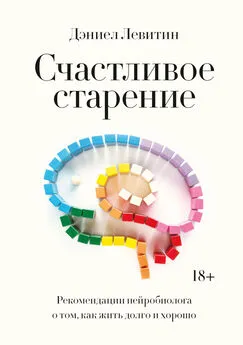Дэниел Левитин - Счастливое старение. Рекомендации нейробиолога о том, как жить долго и хорошо
- Название:Счастливое старение. Рекомендации нейробиолога о том, как жить долго и хорошо
- Автор:
- Жанр:
- Издательство:Манн, Иванов и Фербер
- Год:2021
- Город:Москва
- ISBN:9785001695868
- Рейтинг:
- Избранное:Добавить в избранное
-
Отзывы:
-
Ваша оценка:
Дэниел Левитин - Счастливое старение. Рекомендации нейробиолога о том, как жить долго и хорошо краткое содержание
Ответы на эти и многие другие вопросы вы найдете в книге известного нейробиолога и автора бестселлеров о природе возрастных изменений и о том, как можно прожить долго и что нужно делать сейчас (в любом возрасте), чтобы в 70, 80 и 90 жить полной жизнью.
Книга предназначена для широкого круга читателей.
На русском языке публикуется впервые.
Счастливое старение. Рекомендации нейробиолога о том, как жить долго и хорошо - читать онлайн бесплатно ознакомительный отрывок
Интервал:
Закладка:
235
R. L. Buckner, “Memory and Executive Function in Aging and AD: Multiple Factors That Cause Decline and Reserve Factors That Compensate,” Neuron 44 (2004): 195–208.
236
S. Aichele et al., “Fluid Intelligence Predicts Change in Depressive Symptoms in Later Life: The Lothian Birth Cohort 1936,” Psychological Science (2018): 1–12, http://dx.doi.org/10.1177/0956797618804501.
237
Sternberg et al., “The Relationship between Academic and Practical Intelligence.”
238
В 2020 году судья Джек Вайнштейн вышел на пенсию. Прим. ред.
239
S. L. Brincat et al., “Gradual Progression from Sensory to Task-Related Processing in Cerebral Cortex,” Proceedings of the National Academy of Sciences 115, no. 30 (2018): E7202–E7211.
240
Brincat et al., “Gradual Progression from Sensory to Task-Related Processing in Cerebral Cortex,” Proceedings of the National Academy of Sciences 115, no. 30 (2018): E7202–E7211.
241
A. Susac et al., “Development of Abstract Mathematical Reasoning: The Case of Algebra,” Frontiers in Human Neuroscience 8 (2014): 679.
242
Susac et al., “Development of Abstract Mathematical Reasoning.”
243
S. R. Howard et al., “Numerical Ordering of Zero in Honey Bees,” Science 360, no. 6393 (2018): 1124–1126; A. Nieder, “Honey Bees Zero In on the Empty Set,” Science 360, no. 6393 (2018): 1069–1070.
244
D. Ackerman, One Hundred Names for Love (New York: W. W. Norton, 2011), pp. 82–83. ( Акерман Д. 100 имен любви. М.: ЛитРес, 2015.)
245
S. Kühn et al., “The Importance of the Default Mode Network in Creativity – a Structural MRI Study,” Journal of Creative Behavior 48, no. 2 (2014): 152–163; R. E. Beaty et al., “Creativity and the Default Network: A Functional Connectivity Analysis of the Creative Brain at Rest,” Neuropsychologia 64 (2014): 92–98.
246
T. A. Salthouse, “The Processing-Speed Theory of Adult Age Differences in Cognition,” Psychological Review 103, no. 3 (1996): 403; T. A. Salthouse, T. M. Atkinson, and D. E. Berish, “Executive Functioning as a Potential Mediator of Age-Related Cognitive Decline in Normal Adults,” Journal of Experimental Psychology: General 132, no. 4 (2003): 566; L. J. Whalley et al., “Cognitive Reserve and the Neurobiology of Cognitive Aging,” Ageing Research Reviews 3, no. 4 (2004): 369–382.
247
Whalley et al., “Cognitive Reserve.”
248
P. G. Ince, “Pathological Correlates of Late-Onset Dementia in a Multicenter Community-Based Population in England and Wales,” Lancet 357, no. 9251 (2001): 169–175.
249
Whalley et al., “Cognitive Reserve.”
250
Whalley et al., “Cognitive Reserve”; K. Fujishiro et al., “The Role of Occupation in Explaining Cognitive Functioning in Later Life: Education and Occupational Complexity in a US National Sample of Black and White Men and Women,” Journals of Gerontology: Series B (2017): gbx112, https://doi.org/10.1093/geronb/gbx112.
251
S. Cullum et al., “Decline across Different Domains of Cognitive Function in Normal Ageing: Results of a Longitudinal Population-Based Study Using CAMCOG,” International Journal of Geriatric Psychiatry 15 (2000): 853–862; M. Zhang et al., “The Prevalence of Dementia and Alzheimer’s Disease in Shanghai, China: Impact of Age, Gender, and Education,” Annals of Neurology: Official Journal of the American Neurological Association and the Child Neurology Society 27, no. 4 (1990): 428–437; Y. Stern, “Cognitive Reserve in Ageing and Alzheimer’s Disease,” Lancet Neurology 11, no. 11 (2012): 1006–1012; E. A. Boots et al., “Occupational Complexity and Cognitive Reserve in a Middle-Aged Cohort at Risk for Alzheimer’s Disease,” Archives of Clinical Neuropsychology 30, no. 7 (2015): 634–642.
252
K. Duncker and L. S. Lees, “On Problem-Solving,” Psychological Monographs 58, no. 5 (1945): 1.
253
Существует несколько вариантов и формулировок этой задачи, от первоначальной концепции Дункера до работ Гика и Холиока, а также статей в учебниках по когнитивной психологии. Такая формулировка представляет собой результат выполненного мной объединения всех вариантов. Duncker and Lees, “On Problem-Solving”; M. L. Gick and K. J. Holyoak, “Schema Induction and Analogical Transfer,” Cognitive Psychology 15, no. 1 (1983): 1–38; M. L. Gick and K. J. Holyoak, “Analogical Problem Solving,” Cognitive Psychology 12, no. 3 (1980): 306–355.
254
Умозрительный эксперимент, предложенный одним из создателей квантовой механики Эрвином Шрёдингером. Квантовая суперпозиция, одно из наиболее загадочных явлений, предполагает, что мельчайшие частицы могут находиться в нескольких состояниях одновременно до момента, пока их не измерили. Это явление и реализовано в эксперименте: кот в коробке с синильной кислотой одновременно и жив, и мертв до тех пор, пока коробка не будет открыта ради того, чтобы определить состояние животного. Некоторые ученые доказывают, что возможно измерить квантовую систему, не нарушая ее суперпозиции. Прим. ред.
255
E. E. Lee and D. V. Jeste, “Neurobiology of Wisdom,” in The Cambridge Handbook of Wisdom, ed. R. J. Sternberg and J. Glück (Cambridge, UK: Cambridge University Press, 2019).
256
P. B. Baltes and J. Smith, “The Fascination of Wisdom: Its Nature, Ontogeny, and Function,” Perspectives on Psychological Science 3, no. 1 (2008): 56–64.
257
J. Glück, S. Bluck, and N. M. Weststrate, “More on the MORE Life Experience Model: What We Have Learned (So Far),” Journal of Value Inquiry (2018): 1–22.
258
Согласно библейской притче, две женщины явились к царю Соломону, который был судьей в царстве, и каждая заявила о том, что она мать маленького ребенка. Соломон предложил разрубить ребенка пополам, чтобы поделить его между женщинами. Одна из них согласилась с таким решением, а другая умоляла его не делать этого и отдать ребенка сопернице. Соломон знал, что его совет раскроет любовь настоящей матери и что только истинная мать станет возражать против гибели ребенка.
259
S. Brassen et al., “Don’t Look Back in Anger! Responsiveness to Missed Chances in Successful and Nonsuccessful Aging,” Science 336, no. 6081 (2012): 612–614.
260
I. Grossmann et al., “Reasoning about Social Conflicts Improves into Old Age,” Proceedings of the National Academy of Sciences 107, no. 16 (2010): 7246–7250; D. A. Worthy et al., “With Age Comes Wisdom,” Psychological Science 22, no. 11 (2011): 1375–1380.
261
J. N. Beadle et al., “Aging, Empathy, and Prosociality,” Journals of Gerontology, Series B: Psychological Sciences and Social Sciences 70, no. 2 (2015): 215–224.
262
L. L. Carstensen et al., “Emotional Experience Improves with Age: Evidence Based on over 10 Years of Experience Sampling,” Psychology and Aging 26, no. 1 (2011): 21–33.
263
Brassen et al., “Don’t Look Back in Anger!”
264
L. L. Carstensen and M. DeLiema, “The Positivity Effect: A Negativity Bias in Youth Fades with Age,” Current Opinion in Behavioral Sciences 19 (2018): 7–12.
265
K. S. Birditt, L. M. Jackey, and T. C. Antonucci, “Longitudinal Patterns of Negative Relationship Quality across Adulthood,” Journals of Gerontology, Series B: Psychological Sciences and Social Sciences 64, no. 1 (2009): 55–64.
266
T. W. Meeks and D. V. Jeste, “Neurobiology of Wisdom,” Archives of General Psychiatry 66, no. 4 (2009): 355–365.
267
P. S. Goldman-Rakic and R. M. Brown, “Regional Changes of Monoamines in Cerebral Cortex and Subcortical Structures of Aging Rhesus Monkeys,” Neuroscience 6, no. 2 (1981): 177–187; L. Bäckman et al., “The Correlative Triad among Aging, Dopamine, and Cognition: Current Status and Future Prospects,” Neuroscience and Biobehavioral Reviews 30, no. 6 (2006): 791–807; V. Kaasinen et al., “Age-Related Dopamine D2/D3 Receptor Loss in Extrastriatal Regions of the Human Brain,” Neurobiology of Aging 21, no. 5 (2000): 683–688.
268
R. J. Sternberg, “Why Schools Should Teach for Wisdom: The Balance Theory of Wisdom in Educational Settings,” Educational Psychologist 36, no. 4 (2001): 227–245.
269
S. Wonder, Visions, from Inner Visions, Tamla, T326L.
270
Я уже писал об этом в статье: D. J. Levitin, “Inside the Theater of the Mind. Review of How Emotions Are Made by Lisa Feldman Barrett,” The Wall Street Journal, March 4, 2017, p. B5.
271
R. J. Davidson, “On Emotion, Mood, and Related Affective Constructs,” in The Nature of Emotion: Fundamental Questions, ed. P. Ekman and R. J. Davidson, pp. 51–55 (New York: Oxford University Press, 1994).
272
J. LeDoux, “Rethinking the Emotional Brain,” Neuron 73 (2002): 653–676.
273
F. de Waal, Mama’s Last Hug (New York: W. W. Norton, 2019).
274
R. M. Macnab and D. E. Koshland, “The Gradient-Sensing Mechanism in Bacterial Chemotaxis,” Proceedings of the National Academy of Sciences 69, no. 9 (1972): 2509–2512.
275
S. W. Emmons, “The Mood of a Worm,” Science 338, no. 6106 (2012): 475–476; J. L. Garrison et al., “Oxytocin/Vasopressin-Related Peptides Have an Ancient Role in Reproductive Behavior,” Science 338, no. 6106 (2012): 540–543.
276
LeDoux, “Rethinking the Emotional Brain.”
277
LeDoux, “Rethinking the Emotional Brain.”
Читать дальшеИнтервал:
Закладка:








![Дэниел Левитин - Путеводитель по лжи [Критическое мышление в эпоху постправды]](/books/1101191/deniel-levitin-putevoditel-po-lzhi-kriticheskoe-my.webp)

